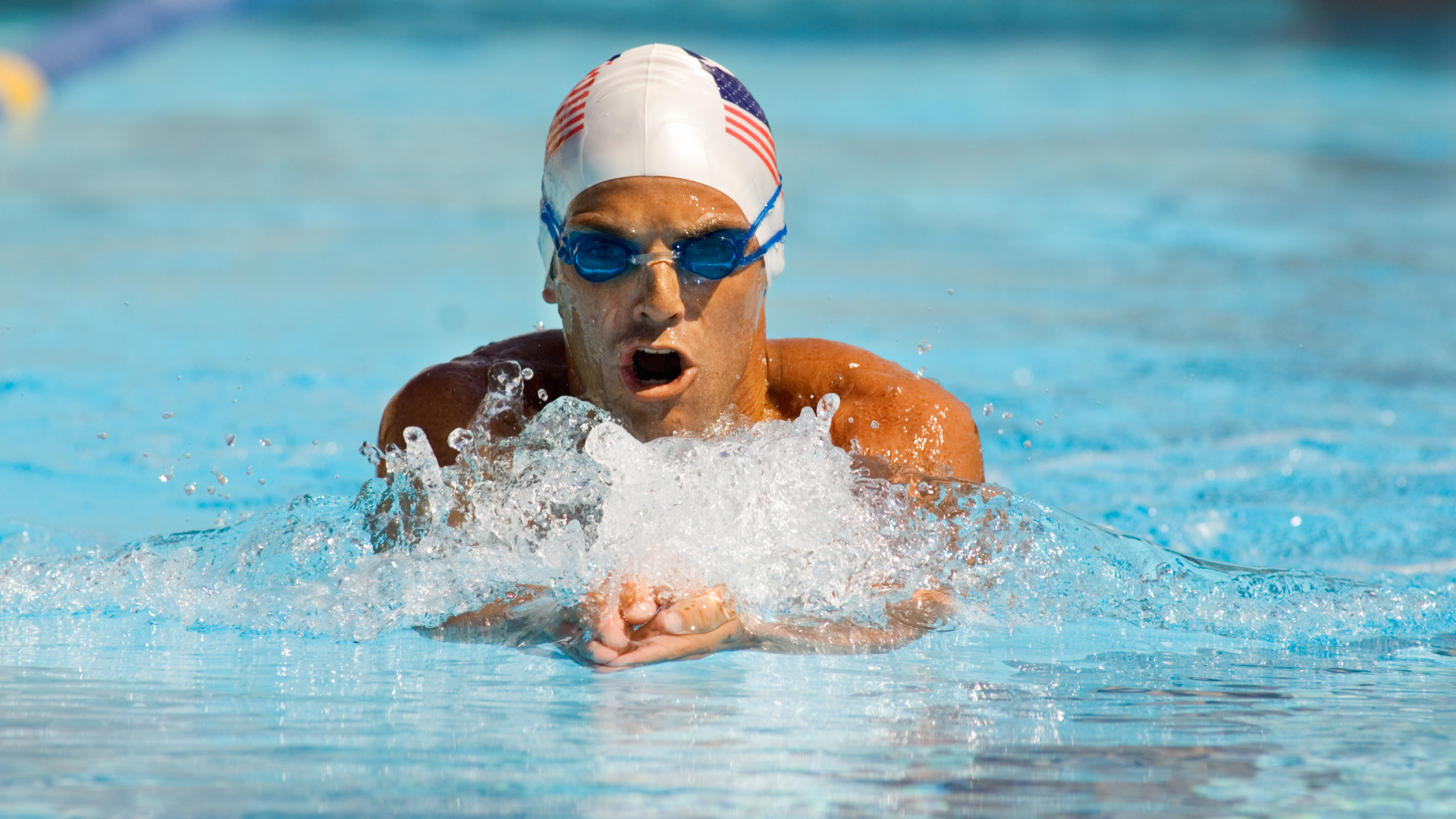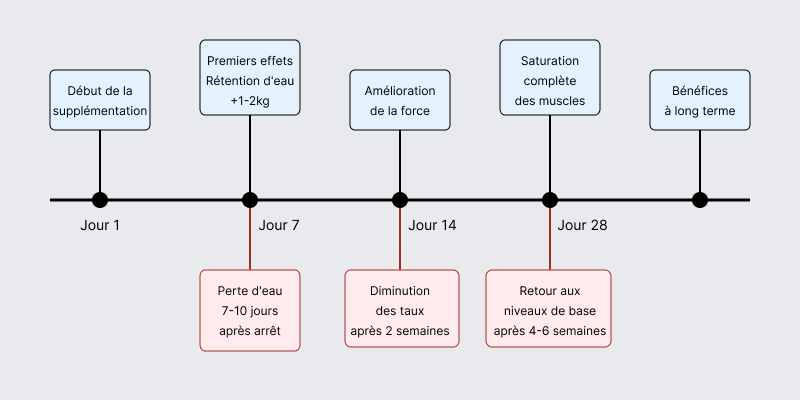Creatine is a dietary supplement which requires between 5 and 30 days of intake to observe its first effects, depending on the protocol chosen. Efficacy and speed of action depend on a number of factors, which we will explore in detail below.
| Main points | Loading protocol (20 g/d for 5 days, then 3 g/d maintenance dose) | No-load protocol (3-5 g/d) |
|---|---|---|
| First observable effects | From 5 days | 3-4 weeks |
| Post-stop maintenance | 3-4 weeks | 3-4 weeks |
| Recommended cycle time | 4-6 weeks | 4-6 weeks |
| Recommended pause time | 4 weeks | 4 weeks |
How does creatine work in the body?
What is creatine and what is its natural role?
Creatine is an organic compound naturally present in our body, mainly stored in our muscle cells. It is synthesized by the body from three amino acids: arginine, glycine and methionine.
Its main role is to contribute to the production of rapid energy during short, intense efforts. In the muscles, creatine binds with phosphate to form phosphocreatine, a molecule essential to the regeneration of ATP (adenosine triphosphate), our main source of energy.
Without supplementation, our natural creatine reserves enable us to maintain maximum effort for just 8 to 10 seconds.
Max effort
Why supplement with creatine?
Creatine supplementation aims to maximize muscle reserves to improve performance during intense effort. Here are the main benefits of a creatine cure:
- Improved strength and explosive power
- Increased training volume
- Better recovery
- Optimizing muscle growth (indirectly)
Creatine monohydrate is the most studied and effective form. Creapure®-labeled creatine, manufactured in Germany to strict standards, guarantees a pure, effective form for athletes wishing to start a course of treatment.
Let's take a look at how creatine's effects manifest themselves according to the various possible intake protocols.

When does creatine take effect?
Protocol with load phase
The loading phase, presented by Professor Roger Harris, represents the fastest method of saturating muscle reserves with creatine and achieving results. This protocol, often adopted by professional athletes, enables results to be observed on their performance in just 5 to 7 days.
Performance enhancement with creatine is based on the principle of saturating muscle reserves. It's only once maximum creatine storage capacity has been reached in the muscles that the benefits in terms of strength and power become apparent.
The principle is simple: start with a high dose of creatine for a short period, followed by a maintenance phase.
- Loading phase: 20 g of creatine per day for 5-7 days, divided into 4 doses of 5 g each.
- Maintenance phase: 3-5 g per day for 4-6 weeks
To optimize assimilation, opt for a post-workout intake, ideally with a carbohydrate source, and don't forget to take it on rest days !
The first effects are generally felt as soon as the 5-7 day loading phase is over: in weight training, for example, this means being able to perform 1-2 more repetitions with the same load, or to slightly increase the maximum load.
Let's move on to the no-load protocol, which offers a more gradual approach but is just as effective over the long term.
Protocol without load phase
The no loading phase protocol, introduced by Professor Eric Hultman, represents a more progressive approach to creatine supplementation. In this method, a maintenance dose of 3-5 grams per day is taken directly over an extended period.
This strategy is particularly suited to athletes who :
- Wish to avoid rapid weight gain due to water retention
- Foresee long-term supplementation (> 30 days)
- Have a history of digestive disorders
This approach offers better digestive tolerance, but requires more patience before the first results can be observed.
With this method, muscle reserves are gradually saturated over 3-4 weeks. Studies show that, after one month, muscle creatine levels are equivalent to those obtained with a loading phase.1
Action time comparison
As previously indicated, the first observable effects appeared after 7 days with the protocol including a loading phase, compared with 3 to 4 weeks with the protocol without a loading phase.
Long-term effects are identical between the two protocols, once muscle reserves are saturated. After 30 days, strength and power performances are similar whatever the method chosen.
After stopping a course of treatment, muscle creatine levels gradually decline over 3-4 weeks, and the effects of supplementation continue for up to 30 days after the treatment is stopped!
How to optimize the creatine intake cycle?
- Active creatine supplementation
- Progression of training loads
- Muscular adaptation and enhanced performance
- Discontinuation of supplementation
- Maintaining performance
- Gradual return to natural creatine levels
A well-structured cyclical approach maximizes the benefits of creatine over the long term:
- ON phase (4-6 weeks)
- Active creatine supplementation
- Progression of training loads
- Muscular adaptation and enhanced performance
- OFF phase (4 weeks)
- Discontinuation of supplementation
- Maintaining performance
- Gradual return to natural creatine levels
Muscle creatine reserves take around 4 weeks to return to their initial level after stopping supplementation.
For maximum efficiency, synchronize your creatine cycles with your periods of intensive training. The OFF phases can correspond to periods of recovery or lighter training. This "stair-step" approach ensures lasting progress.
- Phase 1: Capacity-building with creatine
- Phase 2: Stabilizing earnings during the break
- Phase 3: New progression in the next cycle
Tips to optimize assimilation:
- Avoid taking creatine continuously over a very long period (> 3/4 months)
- Maintain a good level of hydration both during a course of treatment and during a break
- Respect doses
- Take your creatine regularly
- Choose high-quality creatine (Creapure® label).
Conclusion
To conclude, there are two protocols:
- The protocol with load phase: results in 5-7 days, ideal for an upcoming deadline
- The protocol without load phase: results in 3-4 weeks, more gradual and better tolerated
Whichever method you choose, the effects are partially maintained for up to 3-4 weeks after stopping supplementation.

Don't forget that creatine supplementation goes hand in hand with a balanced diet, appropriate training and good recovery.















